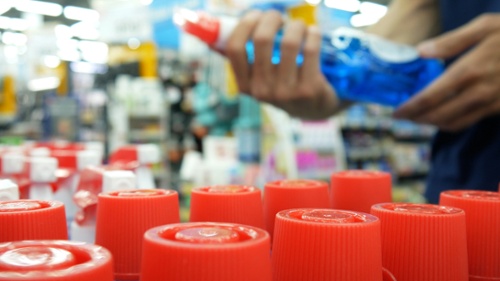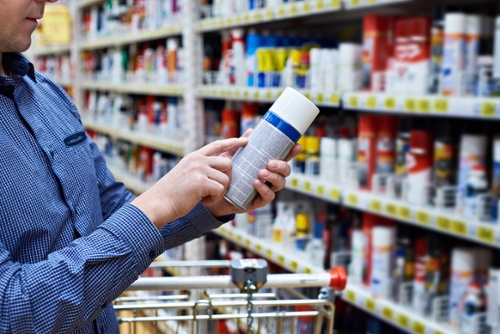There are many retailers who supply dangerous goods to the consumer – even though we may not automatically recognise these everyday products as ‘dangerous goods’. Whether you’re an ag shop selling pesticides, a hardware store providing paint, or a pool & spa retailer offering pool chemicals, there are some key considerations to make to ensure safety for your staff and customers.
Chemical segregation is one of the most crucial safety measures to implement in workplaces where multiple classes of dangerous goods are held. The Australian Standard AS NZ 3833:2007 – The storage and handling of mixed classes of dangerous goods, in packages and immediate bulk containers, explains the requirements that relate to any premises carrying mixed chemical classes. However, there are additional requirements within this Standard for retail shops to ensure chemical incompatibility issues are avoided. We’ll look at just some of these detailed requirements throughout this blog.
REMEMBER: Segregation is defined as the isolation of incompatible goods from each other within the store. To learn more about incompatible substances and the importance of chemical segregation, you can access our free eBook, the Dangerous Goods Segregation Guide.
Segregation of Retail Packages
If substances are recognised as being incompatible, they must be kept apart at all times. In fact, each of the 9 classes of dangerous goods have specific incompatibility issues with other classes (or even chemicals within their own class).
In Section 3.4.4 of the Standard, it explains that incompatible dangerous goods must not be stored together on the same shelf, whether it’s horizontal or vertical storage. Incompatible substances may create a hazard or react dangerously if not kept segregated.

Incompatible substances or those that will react dangerously must be segregated from each other.
If your store is carrying dangerous goods that are classed as Division 6.1 Toxic Substances or Class 8 Corrosive Substances, these packaged products must also be kept away from foodstuffs, foodstuff containers and other articles that aren’t kept in liquid-tight containers and are meant for direct human application. This can be in the form of a 1 metre lateral distance, separate shelves or a liquid-tight partition.
REMEMBER: Every chemical class has its own set of requirements for the safe handling and storage, in addition to the provision for chemical segregation. We recommend that you consult with the safety data sheet, as well as the appropriate Australian Standard, to determine all the chemical controls you need for your store.
Labelling of Containers
In line with the labelling system that applies to your jurisdiction (in Australia, we follow the Globally Harmonised System, otherwise known as the GHS), you must ensure that all labels are intact and visible for staff and customers.
If there are emptied containers, the labels should remain on these until the containers have been decontaminated. After decontamination, the labels can be removed.
Retail Storage Construction
Retail stores which keep dangerous goods must be constructed to meet the requirements of the Building Code of Australia or the Building Code New Zealand.
In addition to these national requirements, the design and construction of retail stores must meet the following:
- Ventilation - Adequate ventilation that’s suitable for the nature of the substances as well as the circumstances of its use.
- Suitable racks & shelves – to reduce the likelihood of spills and leaks, racks and shelves must be structurally sound. The maximum load must be able to safely sit on the shelving system
- Construction materials – racks and shelves should also be unable to absorb liquids and made of a material that’s compatible with the dangerous goods.
Cleanliness and Organisation of Store
To maintain safety when keeping multiple classes of dangerous goods, stores must be properly maintained and monitored.
This includes regularly monitoring your dangerous goods packages, ensuring that incompatible substances are not near each other, and keeping the aisles of your store clear. This will not only allow for a prompt emergency exit, but it also assists with keeping the products in good condition, thereby reducing the likelihood of leaks and spills.

Segregation is made easier when you maintain an organised store, maintaining the integrity and safety of your DG packages.
Spill Prevention
When carrying dangerous goods, leaks and spills can occur if the packages are knocked, dropped or delivered in poor condition.
In addition to thoroughly inspecting your chemical packages upon delivery to your store, you should:
- Train staff to handle all packages with the utmost care.
- Inspect packages for signs of leaks.
- Storing liquids below powders and solids (all compatible substances only).
- Don’t have dangerous goods packages in direct contact with the floor; use pallets or low shelves instead.
- Keeping packages stores so that leaks can’t affect other substances.
- Monitoring of the stock to ensure integrity is essential, as deteriorating packages can lead to chemical hazards.
- Manage chemical leaks and spills as per the requirements for that class (you may also refer to the safety data sheet for your chemical products to determine spill clean-up requirements).
- Have the appropriate spill kits available for trained staff to use for spill containment and clean-up.
Spill Warning and Clean-up
To maintain safety and reduce risk, you must develop procedures to effectively deal with a spill of dangerous goods in your store.
These spill clean-up procedures should include the following steps:
- Hazard identification based on the label and the safety data sheet information for the product that’s been spilled ie. flammability, toxicity, corrosive properties etc.
- Warn staff and customers of the spill.
- Isolate the spill site and display warning signs so no one walks through the contaminated area.
- Check the label on another undamaged container to identify special safety precautions.
- Using the appropriate spill kit, contain and clean-up the spill ensuring that no incompatible materials are used – and no incompatible substances are nearby.
- You may only return the spilt goods to the original packaging if it will not increase the risk.
- Dispose of the chemicals and resulting effluent in accordance with the requirements and local regulations.
REMEMBER: Empty containers and soiled materials can still create a hazard if they’re not disposed of correctly. Small amounts of residue can remain on items, so it’s important that they’re handled in the correct way during the clean-up and disposal process. Consult with your local waste management authority to determine the proper disposal methods for your chemical products.
Emergency Exits and Access
The Standard for mixed classes of dangerous goods explains, in the general requirements section, that:
- Racking and shelving must permit ready access to stock;
- And allow clear access for personnel;
- Dangerous goods must be situated to allow for safe passages to exits;
- Compliant lighting must be installed, for ease of access and safety.
In addition to this, emergency procedures must be in place that are suitable for the chemical hazards (and other hazards) that may occur onsite.
All staff must be trained in the appropriate emergency procedures. Training should start upon commencement of employment, with retraining taking place annually at a minimum. The appropriate personal protective equipment must be provided and maintained for staff.
REMEMBER: Due to the hazards associated with each of the 9 classes of dangerous goods, your emergency planning and evacuation procedures should encompass any scenarios that may occur due to the physical and chemical properties of your stock.
Dispensing of Dangerous Goods in a Retail Setting
While we’ve been looking at closed packages of dangerous goods being kept or sold in stores, it’s also important to remember that many businesses open packages to dispense goods for their customers.
This may include the provision of customised paints (Class 3 Flammable Liquids), pesticides (Class 6 Toxic Substances) or other everyday products.
When dangerous goods packages are open or dispensed, there is a heightened risk of hazardous incidents occurring. Flammable vapours, spilled corrosives, toxic fumes or dangerous reactions with oxidising substances can occur when goods are not sealed within an unopened package.
Issues including air quality, the accidental release of chemicals and the potential for reactions with incompatible substances must be considered in all settings – including retail outlets. Provisions for bunding, spill clean-ups, adequate ventilation, fire control methods and other safety issues must be in place to reduce the likelihood and impact of a hazard occurring.
Paint Shops and other Paint Retailers
As paint is a Class 3 Flammable Liquid, there are safety measures that must be implemented to avoid ignition and incompatible substances coming into contact with each other.

Paints are flammable liquids which must be handled and stored in a way that reduces the risk of ignition or incompatability hazards.
In addition to installing the correct dangerous goods and hazard signage (ie NO IGNITION SOURCES), when tinting flammable paints, or any other opening of a chemical container, the area must be well-ventilated and separated from any potential sources of ignition.
IMPORTANT: Refer to the Australian Standard AS 1940 for further information on controlling ignition risk with flammable liquids.
Segregating Dangerous Goods in Retail Outlets
While there are specific requirements that apply to retail stores — and further requirements for specific industry segments — the basic rules of segregation apply to any facilities carry mixed classes of dangerous goods. For the safety of staff, customers, the community and natural environment, it’s vital that these everyday products are treated in a way that is both safe and compliant.
To learn more about dangerous goods segregation and incompatible substances, why not access our helpful guide. Our eBook provides a solid framework for understanding incompatible substances and those that will react dangerously, with easy-to-understand advice so you can create a safer workplace. Grab your copy today to find out more.
Joining the team as a Dangerous Goods Storage Consultant, Melissa Hampton became Storemasta's Marketing Manager in late 2021. With extensive knowledge and experience in chemical compliance, Melissa is responsible for leading the Marketing team and helping shape their marketing strategy. In her spare time, you can find Melissa hiking, swimming and enjoying the great outdoors in beautiful north-west Tasmania.
